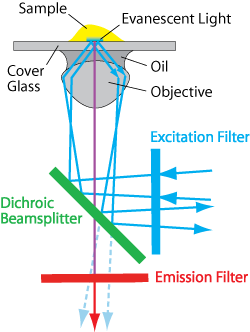
Life Science Optics

With laser fluorescence becoming increasingly popular, there are many new and more demanding requirements of optical filters. Laser excitation requires a laser clean-up filter to block the unwanted light at wavelengths away from the actual laser line, including spontaneous emission often observed in solid-state lasers and the plasma lines of gas lasers. Additionally, these excitation filters should be durable enough to withstand the high intensity of laser beams. High optical durability, combined with the robust environmental reliability of hard-coated filters—which are virtually impervious to thermal and humidity induced degradation—eliminates the need to ever replace the filters for most fluorescence microscopy applications.
 Excitation filters for laser applications also have unique wavelength requirements. Many lasers, like gas and DPSS lasers, have very precise and narrow laser lines
that require a matching narrow laser clean-up filter. Other laser fluorescence systems use either multiple lasers at similar wavelengths (such as 473 and 488 nm for exciting GFP) or diode and optically pumped semiconductor lasers whose output
can vary appreciably from laser to laser, with temperature or as they age. These systems require an excitation filter with a wider bandpass. For example, the UV excitation band of the Semrock laser quad-band set LF405/488/561/635-B is designed to be used with both 375 and 405 nm lasers, with the long-wavelength edge taking into account a ± 5 nm uncertainty in the wavelength of the 405 nm laser.
Excitation filters for laser applications also have unique wavelength requirements. Many lasers, like gas and DPSS lasers, have very precise and narrow laser lines
that require a matching narrow laser clean-up filter. Other laser fluorescence systems use either multiple lasers at similar wavelengths (such as 473 and 488 nm for exciting GFP) or diode and optically pumped semiconductor lasers whose output
can vary appreciably from laser to laser, with temperature or as they age. These systems require an excitation filter with a wider bandpass. For example, the UV excitation band of the Semrock laser quad-band set LF405/488/561/635-B is designed to be used with both 375 and 405 nm lasers, with the long-wavelength edge taking into account a ± 5 nm uncertainty in the wavelength of the 405 nm laser.
Emission filters for laser fluorescence systems should provide high blocking (OD>6) at all laser lines that might be used with the filter set, ensuring the darkest background signal level, while at the same time providing excellent transmission of the emission signal. Emission filters designed for broadband light sources do not always provide sufficient blocking of laser lines and are therefore not suitable for use in laser fluorescence applications.
Dichroics designed for laser fluorescence applications are coated with an antireflective coating in order to maximize transmission of the emission signal and eliminate coherent interference artifacts. A powerful laser excitation beam can encourage autofluorescence that will contaminate the emission signal, so a substrate with very low autofluorescence, such as fused silica, should be used.
The dichroic beamsplitter can have a significant impact on the image quality in certain applications, especially if the flatness (or curvature) of the dichroics is not suitable. For most laser fluorescence applications, the dichroic should be flat enough that there is no noticeable focal shift. This is critical for applications such as TIRF and super-resolution microscopy.
 Demanding applications such as imaging of single molecules using TIRF may impose additional constraints on the blocking of laser beams in the emission channel while maximizing the collection of every possible photon from the fluorophores. In such
situations, conventional bandpass emission filters may be replaced by a long-wave-pass filter keyed to the specific laser line. In our observation, TIRF systems even benefit from using a second emission filter in conjunction with all the filters of
a laser set. The main purpose of the second filter, which should be physically separated from the first emission filter, is to ensure that higher-angle scattered excitation light does not make it through the imaging path to the detector.
Demanding applications such as imaging of single molecules using TIRF may impose additional constraints on the blocking of laser beams in the emission channel while maximizing the collection of every possible photon from the fluorophores. In such
situations, conventional bandpass emission filters may be replaced by a long-wave-pass filter keyed to the specific laser line. In our observation, TIRF systems even benefit from using a second emission filter in conjunction with all the filters of
a laser set. The main purpose of the second filter, which should be physically separated from the first emission filter, is to ensure that higher-angle scattered excitation light does not make it through the imaging path to the detector.
The designs of the excitation and emission filters as well as that of the dichroic beamsplitter should be complementary to obtain the highest fidelity fluorescence visualization. Optical filters play a vital role in obtaining maximum performance from
complex and expensive laser-based microscopes and it is wise to invest in optical filters that match the performance of the imaging system.